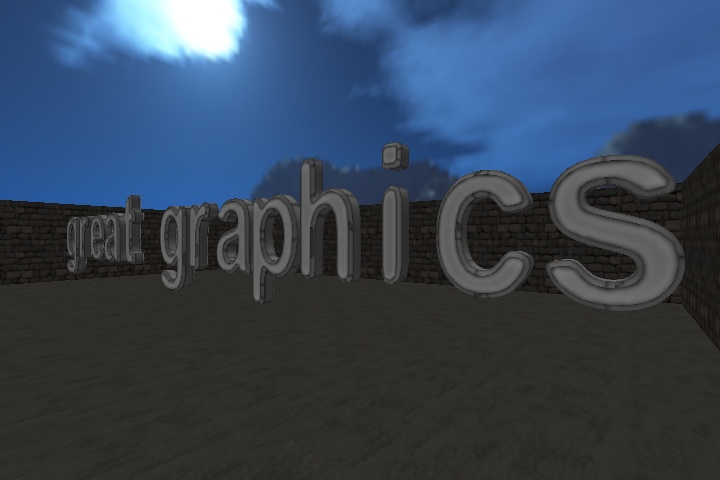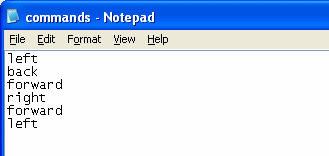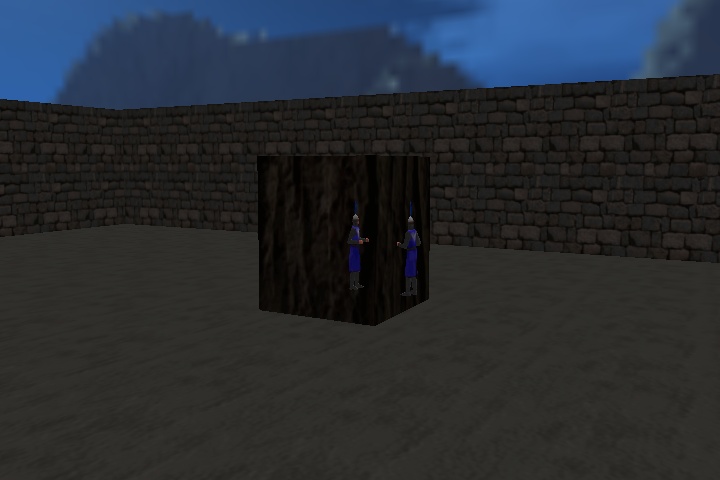Q: I am trying to find a simple example of a working health bar code for the player and an enemy
A: There you go.
var players_health = 100;
var enemy_health = 100;
BMAP* health_pcx = "health.pcx";
PANEL* health_pan =
{
pos_x = 10;
pos_y = 20;
layer = 10;
window(50, 0, 40, 20, health_pcx, players_health, 0);
flags = SHOW;
}
PANEL* enemy_pan =
{
pos_x = 10;
pos_y = 20;
layer = 10;
window(500, 0, 40, 20, health_pcx, enemy_health, 0);
flags = SHOW;
}
// just for testing, use the 1... 4 keys to increase / decrease the health for the player and for the enemy
function health_startup()
{
while (1)
{
if (key_1) players_health += 2 * time_step;
if (key_2) players_health -= 2 * time_step;
if (key_3) enemy_health += 2 * time_step;
if (key_4) enemy_health -= 2 * time_step;
wait (1);
}
}
Q: I would need a teleport, an entity that teleports you to another place in the level when you walk on it.
A: Here's a fully working example.
action my_teleport()
{
set(my, POLYGON); // use polygon-based collision detection
// your player action or function should include a "player = my;" line of code
while (!player) {wait (1);} // wait until the player model is loaded
while (1)
{
if (vec_dist(player.x, my.x) < 100) // trigger distance, play with 100
{
while (key_any) {wait (1);} // wait until the player releases all the keys
// now teleport the player to its new position (choose the vector coordinates properly)
vec_set (player.x, vector (400, 700, -150));
}
wait (1);
}
}
Q: I am writing variables to a file via file_var_write and need to play them back in real time the exact same way they were recorded. The problem is that every time I try to do this it always seems to be a little faster on the playback; is there any way to fix this?
A: Your computer records the data at a smaller frame rate, and then it plays it back at a higher frame rate, thus accelerating the action. A simple solution would be to set fps_max to a smaller value (40... 60); this will allow you to get rid of the problem for good.
Q: What is the best way to display a dynamic text in 3D?
A: Use a character set created out of models and the snippet below as a base for your code.
STRING* display_str = "#40"; // backup string
STRING* temp_str = "#40"; // backup string
var str_count;
var string_index = 0;
var position_y = 500;
function letter_function()
{
set(my, PASSABLE);
my.pan = 270; // orient the letters according to your needs
}
function letters_startup()
{
str_cpy (display_str, "great graphics");
while (!player) {wait (1);} // wait until the player is loaded (if needed)
position_y = 800;
str_count = str_len(display_str);
while (string_index < str_count)
{
str_cpy (temp_str, display_str); // copy display_str to temp_str (we don't want to destroy it)
str_clip(temp_str, string_index); // cut the needed number of characters from the beginning of the string
str_trunc(temp_str, str_count - string_index - 1); // and cut from the end as well
// here we've got the letters that create our string, one by one
// in this example we create them along the y axis (the value of y is decreased at all times until all the letters are in place)
if (str_cmpi(temp_str, "a"))
ent_create("a.mdl", vector(-100, position_y, -100), letter_function);
if (str_cmpi(temp_str, "b"))
ent_create("b.mdl", vector(-100, position_y, -100), letter_function);
if (str_cmpi(temp_str, "c"))
ent_create("c.mdl", vector(-100, position_y, -100), letter_function);
if (str_cmpi(temp_str, "d"))
ent_create("d.mdl", vector(-100, position_y, -100), letter_function);
if (str_cmpi(temp_str, "e"))
ent_create("e.mdl", vector(-100, position_y, -100), letter_function);
if (str_cmpi(temp_str, "f"))
ent_create("f.mdl", vector(-100, position_y, -100), letter_function);
if (str_cmpi(temp_str, "g"))
ent_create("g.mdl", vector(-100, position_y, -100), letter_function);
if (str_cmpi(temp_str, "h"))
ent_create("h.mdl", vector(-100, position_y, -100), letter_function);
if (str_cmpi(temp_str, "i"))
ent_create("i.mdl", vector(-100, position_y, -100), letter_function);
if (str_cmpi(temp_str, "j"))
ent_create("j.mdl", vector(-100, position_y, -100), letter_function);
if (str_cmpi(temp_str, "k"))
ent_create("k.mdl", vector(-100, position_y, -100), letter_function);
if (str_cmpi(temp_str, "l"))
ent_create("l.mdl", vector(-100, position_y, -100), letter_function);
if (str_cmpi(temp_str, "m"))
ent_create("m.mdl", vector(-100, position_y, -100), letter_function);
if (str_cmpi(temp_str, "n"))
ent_create("n.mdl", vector(-100, position_y, -100), letter_function);
if (str_cmpi(temp_str, "o"))
ent_create("o.mdl", vector(-100, position_y, -100), letter_function);
if (str_cmpi(temp_str, "p"))
ent_create("p.mdl", vector(-100, position_y, -100), letter_function);
if (str_cmpi(temp_str, "q"))
ent_create("q.mdl", vector(-100, position_y, -100), letter_function);
if (str_cmpi(temp_str, "r"))
ent_create("r.mdl", vector(-100, position_y, -100), letter_function);
if (str_cmpi(temp_str, "s"))
ent_create("s.mdl", vector(-100, position_y, -100), letter_function);
if (str_cmpi(temp_str, "t"))
ent_create("t.mdl", vector(-100, position_y, -100), letter_function);
if (str_cmpi(temp_str, "u"))
ent_create("u.mdl", vector(-100, position_y, -100), letter_function);
if (str_cmpi(temp_str, "v"))
ent_create("v.mdl", vector(-100, position_y, -100), letter_function);
if (str_cmpi(temp_str, "w"))
ent_create("w.mdl", vector(-100, position_y, -100), letter_function);
if (str_cmpi(temp_str, "x"))
ent_create("x.mdl", vector(-100, position_y, -100), letter_function);
if (str_cmpi(temp_str, "y"))
ent_create("y.mdl", vector(-100, position_y, -100), letter_function);
if (str_cmpi(temp_str, "z"))
ent_create("z.mdl", vector(-100, position_y, -150), letter_function);
position_y -= 120; // set an offset of 120 quants between 2 consecutive letters
string_index += 1; // increase string_index
}
}

Q: How can I control a robot by reading the movement instructions from a text file?
A: There you go.
var string_handle;
var eof_reached = 0; // will be set to -1 when the end of the file (eof) is reached
var temp_coords;
STRING* direction_str = "#10";
ENTITY* robot;
action my_robot()
{
robot = my;
}
function read_startup()
{
while (!robot) {wait (1);} // wait until the robot model is loaded
wait (-5); // give the player some time to prepare for the show (some monitors need a lot of time to switch to the proper resolution)
string_handle = file_open_read("commands.txt"); // open the commands.txt file
while (eof_reached != -1) // the end of the file wasn't reached yet?
{
eof_reached = file_str_read(string_handle, direction_str); // read a string from the file
if (str_cmpi(direction_str, "left")) // read a "left" command? Then let's increase the y coordinate
{
temp_coords = robot.y;
while (robot.y < temp_coords + 50)
{
c_move(robot, nullvector, vector(0, 5 * time_step, 0), IGNORE_PASSABLE);
wait (1);
}
}
if (str_cmpi(direction_str, "right")) // read a "right" command? Then let's decrease the y coordinate
{
temp_coords = robot.y;
while (robot.y > temp_coords - 50)
{
c_move(robot, nullvector, vector(0, -5 * time_step, 0), IGNORE_PASSABLE);
wait (1);
}
}
if (str_cmpi(direction_str, "forward")) // read a "forward" command? Then let's increase the x coordinate
{
temp_coords = robot.x;
while (robot.x < temp_coords + 50)
{
c_move(robot, nullvector, vector(5 * time_step, 0, 0), IGNORE_PASSABLE);
wait (1);
}
}
if (str_cmpi(direction_str, "back")) // read a "back" command? Then let's decrease the x coordinate
{
temp_coords = robot.x;
while (robot.x > temp_coords - 50)
{
c_move(robot, nullvector, vector(-5 * time_step, 0, 0), IGNORE_PASSABLE);
wait (1);
}
}
wait (-1); // wait a second after each command
}
file_close (string_handle); // all the strings are read here, so close the file
}

Q: I would like to know how I can stitch 2 grounds together.
A: Check out function terrain_tile, which can be found in Gamestudio's \include\level.c script file or the terrain sewer project from Aum84.
Q: What is the best way to make an NPC disappear at the end of his path and go back at the beginning over and over? I want to create a dynamic city street scene.
A: Here's an example.
var entity_speed = 3;
var movement_enabled = 0;
var dist_to_node;
var current_node = 1;
var angle_difference = 0;
ANGLE temp_angle, pos_node;
function move_target()
{
while(1)
{
if(movement_enabled)
{
entity_speed = minv(5, entity_speed + 0.5 * time_step);
c_move(my, vector(entity_speed * time_step, 0, 0), nullvector, IGNORE_PASSABLE | GLIDE);
vec_to_angle (my.pan, vec_diff (temp_angle, pos_node, my.x));
}
wait(1);
}
}
action my_entity() // attach this action to a model
{
VECTOR init_pos;
vec_set (init_pos.x, my.x); // store the initial coordinates
move_target();
result = path_scan(me, my.x, my.pan, vector(360, 180, 1000));
if (result) {movement_enabled = 1;}
path_getnode (my, 1, pos_node, NULL);
vec_to_angle (my.pan, vec_diff (temp_angle, pos_node, my.x)); // rotate towards the node
while(1)
{
dist_to_node = vec_dist(my.x, pos_node);
if(dist_to_node < 50) // close to the node?
{
current_node = path_nextnode(my, current_node, 1);
if (!current_node) // reached the end of the path? Then start over!
{
current_node = 1; // reset the node
vec_set (my.x, init_pos.x); // and then teleport the player at its initial position in the level
}
path_getnode (my, current_node, pos_node, NULL);
}
wait(1);
}
}
Q: I'd like the player to shoot fireballs that get destroyed when they collide with other entities.
A: Use the snippet below.
BMAP* fire_tga = "fire.tga";
STRING* fireball_mdl = "fireball.mdl";
SOUND* fireball_wav = "fireball.wav";
SOUND* destroyed_wav = "destroyed.wav";
function fire_fireball();
function shoot_fireball();
function remove_fireball();
function fade_fire(PARTICLE *p);
function fire_effect(PARTICLE *p);
function init_startup()
{
on_mouse_left = fire_fireball;
}
function fire_fireball()
{
ent_create (fireball_mdl, player.x, shoot_fireball);
snd_play (fireball_wav, 50, 0);
}
function shoot_fireball()
{
VECTOR fireball_speed, temp;
my.emask |= (ENABLE_ENTITY | ENABLE_BLOCK);
my.event = remove_fireball;
set (my, PASSABLE);
my.pan = camera.pan;
my.tilt = camera.tilt;
my.skill20 = 0;
vec_set(fireball_speed.x, nullvector);
fireball_speed.x = 100 * time_step;
my.skill10 = 0;
while (my.skill20 < 500)
{
effect(fire_effect, 10, my.x, nullvector);
if (vec_dist (player.x, my.x) > 100)
reset (my, PASSABLE);
if ((my.skill10 == 0) && (vec_dist (my.x, player.x) > 100))
{
// play with 500, sets the damage range
c_scan(my.x, my.pan, vector(40, 60, 500), IGNORE_ME | SCAN_ENTS);
}
my.skill20 += 1 * time_step;
c_move (my, fireball_speed.x, nullvector, IGNORE_FLAG2 | IGNORE_PASSABLE);
wait (1);
}
remove_fireball();
}
function remove_fireball()
{
wait (1);
my.event = NULL;
ent_playsound (my, destroyed_wav, 1000); // play the explosion sound
set (my, INVISIBLE); // hide the fireball, keep ent_playsound playing
wait (-1.5); // wait for 1.5 seconds
ent_remove(me); // now remove it
}
function fade_fire(PARTICLE *p)
{
p.alpha -= 4 * time_step; // fade out the fire particles
if (p.alpha < 0)
p.lifespan = 0;
}
function fire_effect(PARTICLE *p)
{
set (my, PASSABLE);
p->vel_x = 1 - random(2);
p->vel_y = 1 - random(2);
p->vel_z = 3 - random(6);
p.alpha = 20 + random(50);
p.bmap = fire_tga;
p.size = 10 + random(5); // gives the size of the flame particles
p.flags |= (BRIGHT | MOVE);
p.event = fade_fire;
}
Q: I want to create an entity that follows the player. Can anyone help?
A: Here's the code that does what you want.
function player_follower();
action players_code() // attach this action to your player model
{
var movement_speed = 20;
VECTOR temp;
set (my, INVISIBLE);
player = my;
ent_create("guard.mdl", nullvector, player_follower);
while (1)
{
my.pan -= 7 * mouse_force.x * time_step;
vec_set (temp.x, my.x);
temp.z -= 10000;
temp.z = 0;
temp.x = movement_speed * (key_w - key_s) * time_step;
temp.y = movement_speed * (key_a - key_d) * 0.6 * time_step;
c_move (my, temp.x, nullvector, IGNORE_PASSABLE | GLIDE);
camera.x = my.x;
camera.y = my.y;
camera.z = my.z + 50;
camera.pan = my.pan;
camera.tilt += 5 * mouse_force.y * time_step;
wait (1);
}
}
function player_follower()
{
var walk_percentage;
while (1)
{
// play with the numerical values; they give the xyz offset of the follower in relation with the player
vec_set(my.x, vector(150, -60, 0));
vec_rotate(my.x, you.pan);
vec_add(my.x, you.x);
my.pan = you.pan;
ent_animate(my, "walk", walk_percentage, ANM_CYCLE); // play the "stand" aka idle animation
walk_percentage += 5 * (key_w - key_s) * time_step; // increase walk_percentage only if the player is moving
wait (1);
}
}
Q: How can I make certain entities in my level to be visible even if they are behind walls?
A: Here's a simple example.
action hidden_entities()
{
while (1)
{
// press the "v" key to make the entities visible
if (key_v)
set(my, ZNEAR);
else
reset(my, ZNEAR);
wait (1);
}
}
